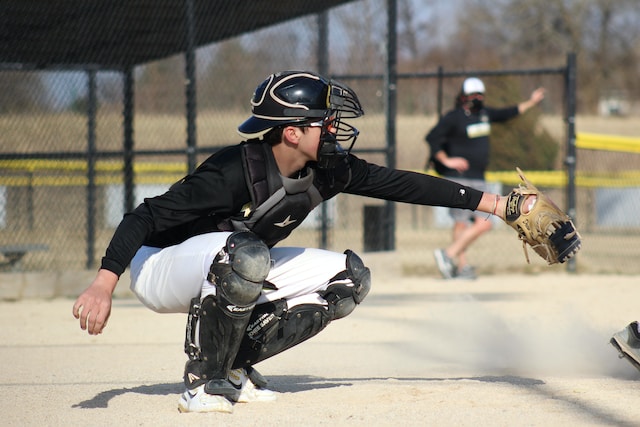The catcher in baseball is the player that stands behind the home base.
The catcher has many defensive responsibilities, but their most important role is to catch pitches and to make strategic decisions about pitches. Also, since the catcher has a clear view of the entire field, they have a leading role in the team’s defensive strategy.
A Catcher’s Stance
A catcher’s stance is important because it affects their ability to quickly react, block pitches and throw.
A catcher’s stance is typically a crouched down position with their feet roughly shoulder width apart and their throwing arm behind their back.
A more relaxed stance is used when there are less than two strikes and no players on the bases. When players are on the bases, a more active stance is used.
Skills for a Successful Catcher
A successful catcher should have excellent hand-eye coordination, arm strength, reactive instincts, overall field awareness, and leadership skills.
Catching & Receiving
A catcher’s main defensive responsibility is to catch the pitch.
It is important that the catcher makes receiving the pitch look clean and effortless so that the umpire considers it a ‘strike.’
Here are some ways to make catching a pitch look seamless:
- A catcher should hold their glove where the ball should be thrown. This will provide a target for the pitcher.
- Catchers should move their glove as soon as they see where the pitch is going. This will allow them to hold the mitt as they catch the ball. This simple detail makes the pitch look more like a ‘strike.’
- A catcher should not reach for the ball, but let the ball come to their glove.
Throwing & Arm Strength
A catcher needs to be able to throw across the field to their teammates in the outfield.
Since a catcher can see the whole outfield at all times, they can see when basemen are trying to steal bases. Catchers need a strong arm to make quick and accurate throws to prevent the opposing team from getting around the bases, crossing home plate and scoring runs.
Blocking
When a bad pitch is thrown where a ball hits the ground and bounces, a catcher must block the ball. If the ball gets past the catcher, it is considered ‘in play’ and the opposing team can run around the bases and score runs. It is essential that a catcher is a good blocker and can get control of the ball as quickly as possible.
To be a strong blocker, a catcher must be quick to react and agile so they can position their body to block the ball.
In order to successfully block the ball, a catcher must get to the spot where the ball is going, drop to their knees, put their mitt in between their legs and most importantly, the catcher should lean forward to keep the ball from rebounding or bouncing off of them.
Game Management, Strategy & Leadership
With a clear view of the entire field, catchers have a leading role in the team’s defensive strategy.
The catcher mediates communication between the coaches and the outfielders. They work closely with the coaching staff before the game to study the opposing team’s hitting patterns and tendencies. During the game, the catcher is responsible for signalling and communicating defensive strategies to his teammates based on the information they studied and any other communication from the coaches.
A primary role of the catcher is to signal to the pitcher what type of pitch should be made. Catchers need to signal pitches based on the game score, the number of players on the bases, the pitcher’s strengths, and the hitter’s strengths and weakness. Since the catcher has observed and studied every batter’s hitting patterns and tendencies, they know what type of pitch may be harder for the batter to hit.






